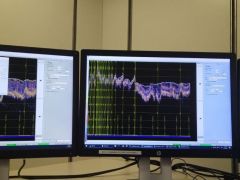
Home run for the RV Maria S. Merian:
Research vessel sets off towards the Baltic Sea ice
for the "Deep Baltic" mission
18.03.2021 – Night owls on board: Looking into the Depth
A geological focus of our voyage is to understand why the layers of the Little Ice Age are preserved in some places of the Baltic Sea and where they have already been eroded again (see blog entry 5). But how do you know, where the appropriate place to take samples is, where to pull a sediment core from the seafloor, and what tube length to choose to catch all the layers of interest? To avoid blindly poking around on the seafloor, we get an overview of the seafloor before sampling.
Anyone who has been on a ship knows echo sounders, which determine the water depth. We use special echo sounders that are permanently installed in the ship's hull and can "look" into the seabed. The emitted sound signal penetrates the sediment and is reflected back to the ship whenever the material changes. These echoes are converted by the computer into an image that reflects the different sediment layers.
On research voyages, it is usual to survey the seafloor at night so that deck work can take place during the day. On this voyage we are two people, who are mainly responsible for the hydroacoustics and turn night into day. Supported by many eager students, we are never alone and you can get a coffee (very important) or go to the toilet, because there must always be one person in front of the computers and keep an eye on the measurements.
Early in the morning we take turns. Now the first new data are already copied to a second computer and graphically displayed by the help of special computer programs. This is very important, because around 6 a.m. the chief scientist shows up together with the chief geologist. They ask: "Was there anything exciting this night?". Based on the new data, we jointly select core stations for the day.
The biggest challenge is not to select too many stations even though there is so much of interest to see. Once the core locations are determined, the coordinates are sent to the bridge. A map is quickly completed and printed out so that the rest of the deck scientists know what's coming up for the day, and then it's time for breakfast and the night shift is over.
Text: Svenja Papenmeier (IOW)
Photo: Kerstin Brembach (IOW) | click photo to enlarge
| Expedition: | MSM99 |
| Mission: | Deep Baltic |
| Start: | 25.02.2021 - Emden |
| Destination: | 23.03.2021 - Emden |
Maria S. Merian: current position
